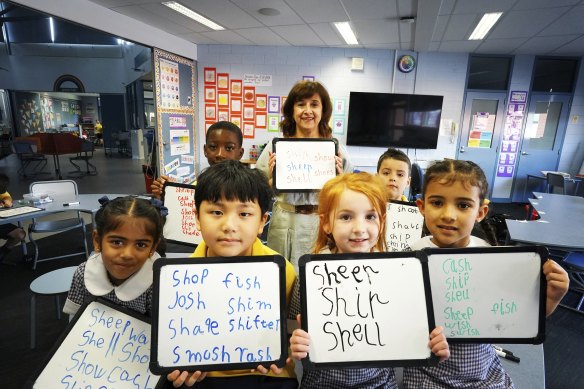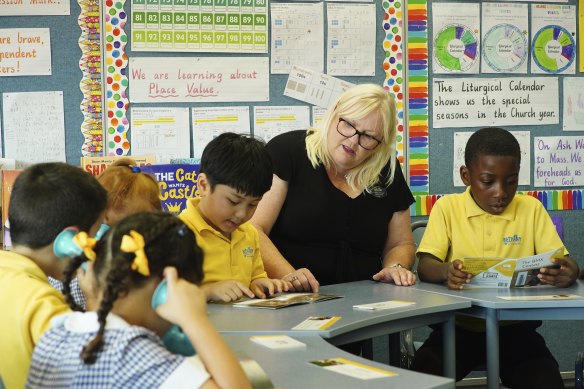By Robyn Grace
Catholic schools in Melbourne will overhaul how students learn reading, writing and maths in a move expected to ramp up the pressure on the Victorian government to give greater guidance to its own teachers.
Melbourne Archdiocese Catholic Schools on Thursday launched a ‘Vision for Instruction’ for its 300 schools, saying the evidence now supports explicit instruction as the best way of teaching children.

Bethany Catholic Primary School principal Joanne Webster and her students have experienced the benefits of explicit teaching.Credit: Luis Enrique Ascui
The move is a departure from the public system, which allows schools to choose their own teaching methods, despite many experts regarding some of those as outdated.
After a similar shift across dozens of Catholic schools in NSW and the ACT in 2019, the proportion of students underperforming in reading went from more than 40 per cent to just 4 per cent over three years.
Melbourne Archdiocese Catholic Schools executive director Dr Edward Simons said years of declining results in the global Programme for International Student Assessment meant approaches to teaching and learning needed to change.
He said explicit instruction methods had “clearly shown us that our education systems can be much more effective at educating our children”.

Literacy leader Kirrily Wallace with students at Bethany Catholic Primary School.Credit: Luis Ascui
Melbourne is so far the largest system to switch tack, with the move affecting 115,000 students and about 16,000 teachers and support staff.
Explicit instruction promotes direct teaching over student-led or inquiry-based learning, breaking down new concepts into smaller steps and modelling each step before progression. The method is underpinned by an evidence-based, scientific understanding of how students learn.
The practice has already been embraced by individual schools in all sectors, but the Melbourne Archdiocese will embed a system-wide approach, providing teachers with training and curriculum resources to ensure each school operates under the same framework.
Bethany Catholic Primary School in Werribee transformed its teaching last year after a review in 2022 made it clear to principal Joanne Webster that what they were doing wasn’t working.
Webster had previously used balanced literacy with some success but said there was always a percentage of students who didn’t improve. She said it became obvious explicit instruction could bridge that gap.
She hired a consultant to guide her teachers through the implementation of explicit instruction and “it just took off”.
“By the end of the year, the growth was significant,” she said.
Bethany has removed composite classes this year to accommodate the teaching. Class sizes in early grades have also been reduced to allow for earlier intervention.
Webster, who was on the reference group for the Melbourne Archdiocese’s plan, said the system overhaul affirmed she had made the right decision.
“I’ll be really interested to see our results in NAPLAN this year,” she said. “But you know what was really exciting was the kids were coming up and saying how much they were loving the learning.”
Jennifer Buckingham, director of strategy at literacy company MultiLit, said support for explicit instruction had been growing for about 10 years but the size of the Melbourne Archdiocese made its decision significant.
Buckingham, who contributed to the Archdiocese’s vision statement, said it would take time for results to filter through the whole system, but that improvements at a school level should be visible fairly quickly.
Buckingham said the initiative, which aims to make every student proficient in literacy and numeracy, could encourage a greater take-up of explicit instruction nationwide.
“I think results will end up speaking to themselves,” she said. “It’s one thing to be able to point to individual schools and say these schools … are getting fantastic results doing something that’s different to what it’s been advised by the department.
“It’s a different thing again when you have a very large group of schools … start to demonstrate great results. That’s quite hard to ignore.”
The Melbourne Archdiocese is not the first system to adopt explicit instruction.
In the Canberra and Goulburn region, where 56 schools adopted the practice in 2020, the proportion of year 3 students underperforming in NAPLAN reading tests lifted from 42 per cent in 2019 to only 4 per cent in 2022. Government students dropped from 54 per cent to 60 per cent underperforming in the same period.
Ballarat Clarendon College, consistently Victoria’s top VCE performer, also uses explicit instruction.
Public systems in South Australia, NSW, Queensland and Tasmania have adopted explicit instruction for reading.
The 2022 PISA results, released last year, showed almost half of Australia’s 15-year-old students are failing to achieve national standards in key areas of maths, science and reading, and the nation is now more than four years behind the world’s top-performing jurisdiction in maths.
When school and student-level socioeconomic background were factored in, independent and government schools performed better than Catholic schools in maths and science. For reading, there was no advantage for independent students, but government students performed better than Catholic students.
Trisha Jha, from the Centre for Independent Studies think tank, is the author of two recent reports on the science of learning and explicit instruction.
The latest, released on Thursday, said teachers were strongly motivated to fix educational inequity but were not adequately guided by school systems. This, coupled with often conflicting advice around best practice, left schools responsible for their own professional development and teachers relying on informal networks to build up knowledge.
Jha said the Melbourne Archdiocese Catholic Schools’ announcement would increase the pressure on the Victorian Education Department to remove contradictions in its own advice to schools.
“I would just point out that it’s about raising the quality of education across the whole state,” she said. “And I would think that any government would be interested in that, regardless of whether the child happens to attend a state school or a Catholic school.”
A Victorian Education Department spokesperson did not answer questions about clearer guidance for schools but said the government was investing $40 million to develop lesson plans reflecting “the best and most contemporary evidence of what works”. These would be available from the second half of this year.
“Explicit teaching is a core component of the Victorian teaching and learning model and this is already being delivered in government schools,” the spokesperson said.
Opposition education spokeswoman Jess Wilson said the evidence on best-practice teaching was clear, but public school students were increasingly left behind.
“With the non-government sector embracing modern, evidence-based teaching techniques, the Allan government must now follow suit and ensure every student has the best opportunity to reach their full potential.”
Start the day with a summary of the day’s most important and interesting stories, analysis and insights. Sign up for our Morning Edition newsletter.